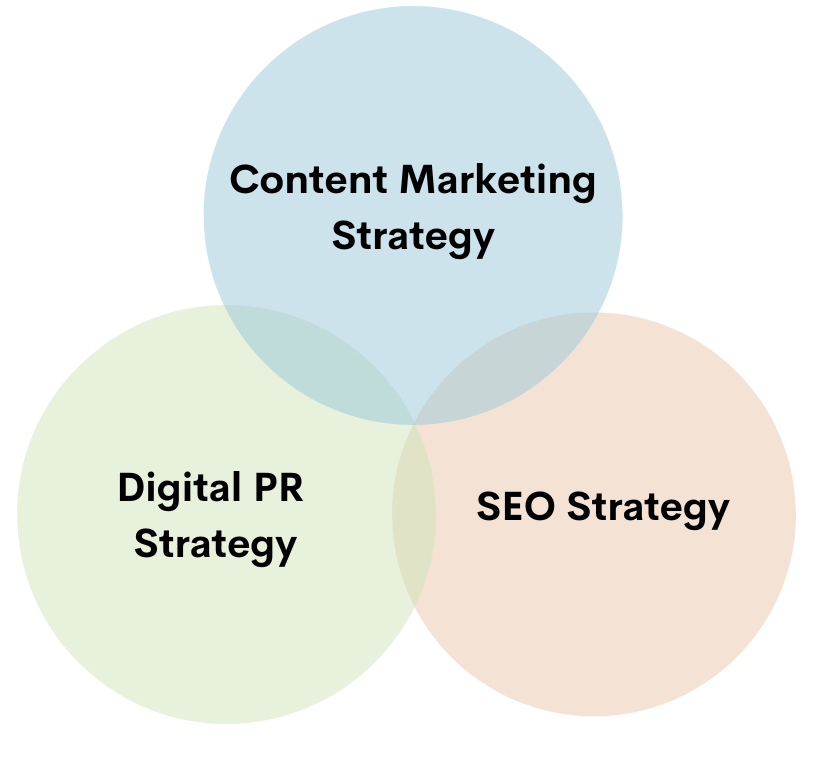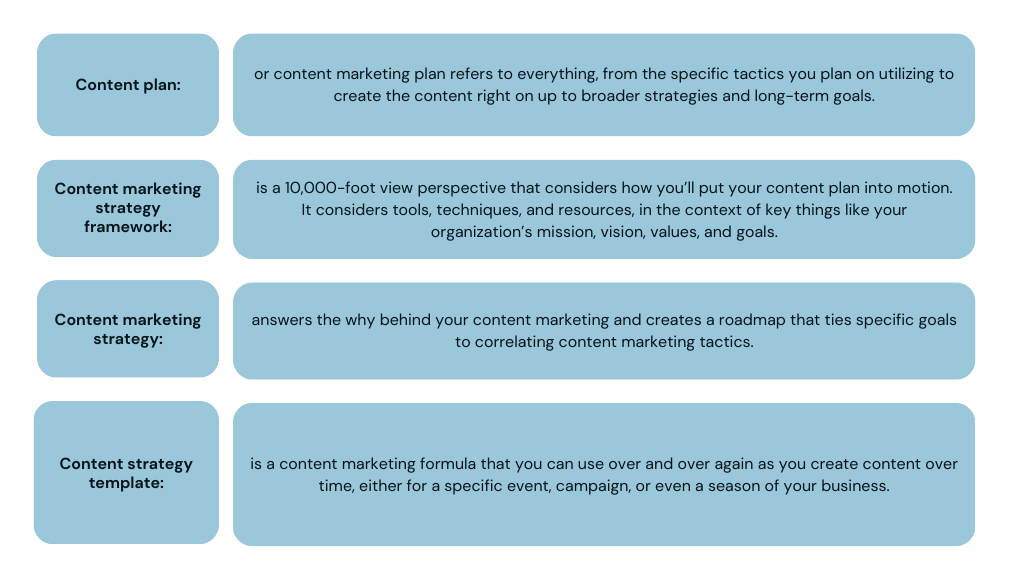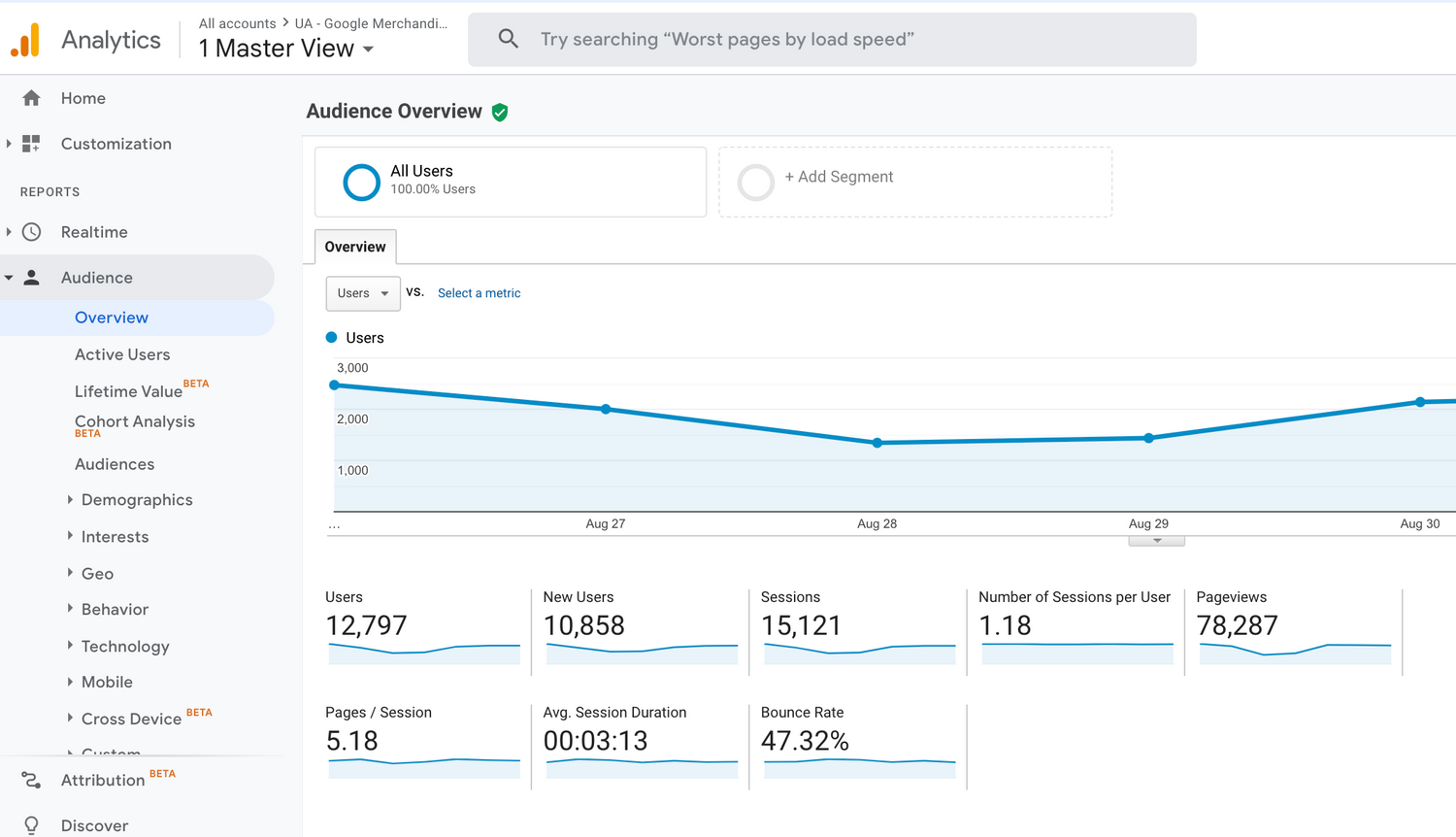Everyone is quick to prioritize content as the biggest piece of a successful digital marketing strategy. But what does it look like to actually create content that converts?
What channels, like blogs and emails, are the best forms of content marketing for your business? What should your content look like? What topics should it cover? How will it help you achieve your larger growth marketing goals?
These are important questions that you can only answer with a comprehensive content marketing strategy.
Content consists of pieces of marketing assets that you can use to promote a brand. Everything from social posts and blog articles to guest posts, podcasts, and drip campaigns counts under the massive and diverse umbrella that is marketing content.
A strategy is a plan of action. It takes your assets, abilities, and other resources and considers how you can use them to achieve your goals. You can create a strategy to meet a short-term goal on the way to a larger one, such as hitting a particular KPI in the next month. You can also create strategies focused on single, larger objectives, like achieving a certain percentage of growth in sales by the end of the year.
When you combine these terms, you get a content marketing strategy. This form of business content strategy considers how you’ll achieve your marketing goals through your content creation and curation.
Content strategy is much bigger than picking out your next blog topic or finding a good quote to post on Instagram. It looks at your larger company goals and integrates them into what you’re doing and where you’re trying to go as you create your content.
A good content strategy considers content for the entire buyer's journey, not just the most interesting topics or pieces of media. Content Marketing Institute adds the important clarification that a strategy designed to guide your content marketing should function as your “why.” It should answer key questions, including:
These are important questions to answer if you want your content to help you meet your marketing goals.
Okay, content marketing strategy is the “why” behind your content creation efforts. But why does having the “why” help in the first place?
What is it that makes putting a strategy behind your content creation so important? The simple answer is that a strategy organizes and amplifies the impact of your content.
Without a strategy, content tends to be listless and directionless. Will it help consumers? Possibly. Will it generate traffic, revenue, or whatever else you’re trying to accomplish? Maybe at some point. But that isn’t certain or predictable.
Too often, marketers put content creation first and strategy second. They focus on fun, exciting ideas without taking the time to consider how each piece of content contributes to your business as a whole.
A content marketing strategy unifies your content creation efforts and points them in a single direction. It ensures that everything supports itself and is interwoven together in the single pursuit of achieving your business’s goals. How will it spur your audience to take action, jump into your funnel, and begin (or continue) their buyer journey?
A content marketing strategy turns individual pieces of content into a single, unified, and powerful part of your larger growth marketing strategy.
It’s easy to see how a content marketing strategy can amplify the impact of each individual piece of its content components. But how does your content marketing strategy as a whole factor into your larger growth marketing strategy?
At Relevance, we see content marketing as one of the three major parts of an effective growth strategy. This important trio consists of the following:

Each of these addresses one of the three pillars of a strong growth marketing strategy:
Not only does content marketing play an important part in building brand authority. It also serves as a key contributor to the other two pillars. For instance, quality onsite content is required to execute an effective digital PR campaign. In addition, good content should answer targeted questions that consumers are searching for (i.e., answer search intent). This improves the search engine optimization side of things and helps you rank better in Google SERPs.
From its leading role as an authority-builder to its support function for digital PR and SEO, your content and the strategy behind it can be a game-changer for your growth-oriented endeavors.
Unsurprisingly, content marketing can take many different forms. We’ve already mentioned a handful of these as we went along. But here is a more comprehensive list of each valuable content type for quick reference:
Even this exhaustive list doesn’t have every option and nuance. For instance, a “blog post” refers to onsite content. However, it’s technically different from a sales page, which is also a form of onsite content.
The former is a piece of content that seeks to inform the consumer and guide them along the funnel (different pieces of content address top, middle, and lower sale funnel CTAs). The latter is at the end of the funnel and prioritizes promoting a product or service and closing a sale.
Similarly, infographics are a specific form of visual content. However, you can also create memes, photos, illustrations, and other forms of still media.
The point is that the above list isn’t an authoritative group of items that have to be included in a content strategy. Think bigger than something that is that formulaic.
Content marketing should never be restricted to one or two of these options, and, at the same time (unless you’re a very large company with lots of resources), you shouldn’t try to utilize every one of them at once. If you do that, you’ll spread those resources too thin, and nothing will be too effective.
Instead — get this — you need to take the time to create a marketing strategy. (Big surprise, right?) A quality strategy will help you choose what forms of content you should use based on your audience, how you should make them, and, ultimately, how you should deploy them in your larger growth strategy.
Grasping the value of a good content marketing strategy is important. Seeing how that fits into the bigger marketing picture is essential. Understanding the different types of content marketing that you can utilize gives you a versatile advantage.
But how do you bring all of these tools and information together? Here is a rapid-fire, step-by-step run-through for how to create a rock-solid content marketing strategy for your company.
PRO TIP: Terminology is important here, so let’s make sure we’re on the same page before we dive in:

Okay, now that we’ve clarified our vocabulary, let's see what it takes to flesh out an effective content marketing strategy.
You can’t market effectively if you don’t know who you’re marketing to. That’s why, as you consider your content marketing strategy framework, you want to start with your audience.
Any growth marketer worth their salt keeps the consumer at the center of every decision. If you’re already an established business, you should have a target audience identified. Review, update, and codify this information.
You also want to consider the customer journey. What is the process that leads a consumer from their first point of relevant content through the sales funnel and on to remain a retained and happy customer? Your content should align with some part of this journey at all times.
Notice the word “should” here. This isn’t time for a “pick your favorite topic” kind of conversation. What are the specific themes that absolutely should personify your brand? What topical areas should your brand be an industry leader in?
As you figure these out, each theme can become one of your pillars. Content pillars (like this one you’re reading now) are unique, long-form content that comprehensively addresses an important topic for your brand.
A good pillar strategy identifies a handful of key pillars. You can then use these central points to build off of as you create smaller pieces of “clustered” content around them. This keeps your blog content focused and strategic.
Research is a major part of laying the groundwork for a successful content marketing strategy. This starts with keywords. As you identify your themes, consider what keywords people are using to search for information in those areas.
It’s also wise to conduct competitor research. What content are your competitors creating? What keywords are they ranking for? These are good indications of the areas you should focus on, either to beat out the competition or differentiate yourself to rank for different longtail keywords.
As you consider your audience, buyer journey, themes, pillars, keywords, and competitors, you can begin to see what your content marketing strategy should look like. You can envision the broad, sweeping goals that you should aim to accomplish through your content.
As this comes into focus, begin to consider what goals you should target throughout your content creation. Once you’ve established end goals, you can also create KPIs that serve as mini-objectives to keep you on the straight and narrow as you go along.
Content creation is a cost-effective and efficient way to generate traffic and boost brand authority over time. However, upfront and in the short term, content creation is expensive and time-consuming. The last thing you want to do is create content you don’t need.
Once you have your goals and KPIs in place, review your existing content in light of your new content strategy plan. What content is already in that subject area?
If you have content that is close but not quite there yet, you can create a content optimization strategy to clean it up and introduce the right keywords and linking strategy.
Now that you have a strategy in place, goals set, and have vetted your existing content, it’s time to add more content. This starts with a solid content creation process.
Effective content production starts with your team. Figure out which people in your organization, department, and marketing team should be involved.
From there, set up a system to:
Once that’s set, it’s time to create the content itself.
It’s time to have your team generate new content. Have your writers write, your illustrators create images, and so on.
Make sure you’re ready to edit content and optimize it before it goes live, as well. If you’ve set the stage by following the steps before this point, this part should be relatively straightforward and simple.
Your content may look shiny and exciting when it’s initially completed, but you won’t know if it’s actually performing for a while. That’s why you need to track data as you go along.
You can use a tool like Google Analytics to monitor key metrics like organic traffic, session duration, and bounce rate.

Once your content goes live on your site, it will take some time to start performing. Nevertheless, you don’t want to publish something and never revisit it. We recommend checking your analytics every six months or so to see how it’s going.
If it isn’t performing well after several months, re-optimize your content. Use this ongoing data collection process to see what works, too. That way, you can reiterate it across both your existing and new content moving forward.
Every company does content marketing differently. Each campaign looks different, too, depending on that brand’s current needs, audience, and so on.
Here are a couple of examples of how different quality content can look based on some of the best content marketing brands out there.
Content marketing works for any industry — case in point: the Mr. Rooter plumbing blog. The plumbing franchise has a blog filled with dozens of articles. Each of these provides genuine value by targeting not just plumbing questions but also customer pain points.
Every article approaches problems from the customers’ perspective, such as dealing with tree roots in sewer lines or backed-up garbage disposals. These are high-value articles that, of course, include CTAs for plumbing services if the DIY approach falls through.
Another content strategy example is Patagonia. The high-end clothing brand was built on providing quality outdoor clothing whilst avoiding unnecessary harm to the earth in the process. With an informed and invested customer base, the brand doesn’t waste its time creating low-quality or low-information content.
Instead, it dives into long-form content created to entertain and inform. It also presents this information in a beautiful video format that is showcased right on its website. This significant investment is keeping the brand’s high-profile customer base interested and invested in its larger message.
When you think of content, you may not think of fast food. However, some fast food chains are exceptionally good at utilizing their online content to keep customers flowing to their doors.
Taco Bell is one of those. The company has maintained a strong sense of content consistency across its various online efforts.
The most popular of these is its social media channels. Taco Bell’s social accounts operate like clockwork, providing a steady flow of mouth-watering imagery that aligns with their tone and keeps their crowd engaged and interested.
If you’re going to invest in a content marketing strategy (which is always a good idea), you need to remember that this isn’t a one-and-done activity. It requires ongoing tweaking, learning, and adapting to wherever the current content landscape is going.
For instance, artificial intelligence is impacting content more all the time. Already, content creators use AI to brainstorm ideas, create outlines, conduct keyword research, and more.
At the same time, in mid-to-late 2023, Google was still in the midst of testing its Search Generative Experience (SGE) technology. This development has the potential to completely rewrite how online search takes place.
In the midst of all of this change, Google is also rolling out its Helpful Content Updates. These will provide insights into how brands can take advantage of the latest search engine algorithms and developments to help ensure their content is found by their target audience.
These kinds of changes are generally good things. However, they can shake things up in the short term and often require adjustments and adaptation whenever they roll out.
That’s where working with a good growth marketing agency like Relevance can help you stay ahead of the curve. If you want to create great content, invest in up-to-date relationships with marketing professionals who have their finger on the pulse of the industry. This will help you navigate the future of content strategy and management as you go along.
Content marketing is a major part of modern marketing plans. However, simply creating content with a “let’s see what sticks” mentality won’t get you far.
In order to see content marketing success, you need to invest in a killer content marketing strategy. This gives you a clear focus and purpose as you tend to all of your content creation and management efforts.
Whether you’re creating content in the form of emails, blog posts, podcasts, videos, or anything else, always make sure you have a strategy in place to guide you as you go along.